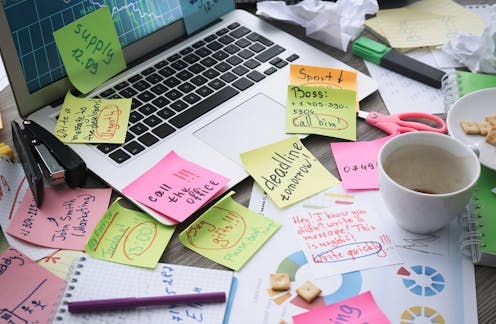Source: The Conversation (Au and NZ) – By Kim M Caudwell, Senior Lecturer – Psychology | Chair, Researchers in Behavioural Addictions, Alcohol and Drugs (BAAD), Charles Darwin University
It feels like we are living in busy times.
According to the OECD Better Life Index, 12.5% of Australians report working at least 50 hours a week, higher than the OECD average. Many Australians are also working more than one job to buffer against cost-of-living pressures.
Psychology has long been interested in our goals – our mental representations of desirable outcomes. Much of this research is on how we form, pursue and attain goals, plus how goals make us feel. Across studies, we see a consistent pattern of successful goal pursuit and wellbeing. So, having time to work toward our goals is important.
With this in mind, what is the best way to get things done – and how can we get better at achieving our goals, especially when we feel time poor?
Make a list
Most of us approach multiple goals with the age-old “to-do” list. First, you write down everything you need to do. Then you “check” or tick things off as you do them.
One reason to-do lists are useful is because we are more likely to remember things we haven’t completed, rather than things we have. This is known as the Zeigarnik effect.
While to-do lists are easy to write, they don’t always work. There are however various approaches for to-do lists that may improve their effectiveness.
Another thing to consider is the wide range of apps, tools and platforms that can make tasks more fun and outsource mental load. Adding elements of game play like point scoring or competition – called “gamification” – can help people work toward goals in educational and work settings. Similarly, app-based reminders can help people reach physical rehabilitation goals and form good exercise habits.
Finding your why
Researchers have focused a lot on the psychology of why people pursue goals – and how this affects their approach to tasks.
For example, some people want to complete a university degree because they want to get a job. Others may be more interested in developing skills or knowledge. In both cases, there is a desired outcome – albeit with differing reasons.
Our goals can be differentiated by who or what is driving them. Goals that feel like our own, and for which we experience a sense of intrinsic motivation, are known as “self-concordant”. These goals represent enduring personal interests, are aligned with values and are positively linked to wellbeing.
Goal orientation theory offers a similar perspective. Using the same example, you may study so you score well on a test (a performance goal) or because you want to be sure you develop your knowledge (a mastery goal). Mastery goals tend to lead to better results and self-regulation.

Thapana_Studio/Shutterstock
Juggling goals – 4 to-do tips
So, what happens when we have multiple – perhaps even competing – goals, or goals that aren’t so enjoyable? We might want to finish writing a report or assignment, then read a few chapters of a textbook – but also go to the gym and binge a few episodes of our favourite TV show.
In such scenarios, psychological science offers some insights into how we might stay task-focused, and on track to tick more items off our to-do list.
1. Beware the planning fallacy. This happens when we underestimate the amount of resources (such as time) it will take to reach a goal. As writer and religious thinker William Penn put it: “Time is what we want most, but what we use worst”. Think through the all the steps and time required to complete your goal.
2. Monitor your progress. Incorporating goal monitoring into an activity can boost progress. And reviewing your estimations and expectations against your actual times and achievements can be used to calculate a “fudge ratio” to aid future planning. For instance, you could multiply your expected time on tasks by 1.5 to help buffer against the planning fallacy.
3. Focus on mastery. Self-concordant goals and tasks feel easier, and their underlying tasks may be less subject to forgetting. Tedious but necessary goals (such as doing the dishes or filling out forms) are less intrinsically motivating. This means planning, reminders and support become more important to goal progress.
4. Plan for derailments. People vary in their ability to plan and might forget to take a goal-directed action at an appropriate time (this could be one reason the average Australian streams 27 hours of video each week). Implementation intentions bring our attention back toward our goals by linking them to an environmental marker. These simple “if-then” plans are shown to help overcome issues with self-regulation. Such a statement might be “if I see the ‘next episode’ icon appear, I will get up and turn off the TV so I can read a chapter of my textbook”.
With time being frustratingly finite, it is inevitable we will run out of time to do all of the things on our to-do list. Finding an approach that works for us will take time and effort. But it’s probably a worthy goal in itself.
![]()
Kim M Caudwell does not work for, consult, own shares in or receive funding from any company or organisation that would benefit from this article, and has disclosed no relevant affiliations beyond their academic appointment.
– ref. To-do list got you down? Understanding the psychology of goals can help tick things off – and keep you on track – https://theconversation.com/to-do-list-got-you-down-understanding-the-psychology-of-goals-can-help-tick-things-off-and-keep-you-on-track-230399








